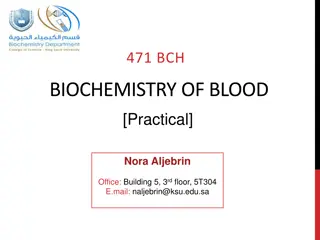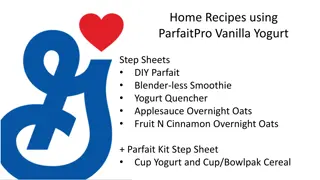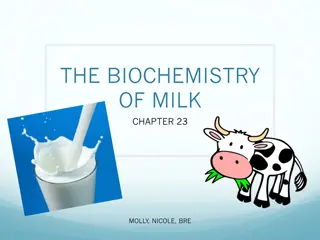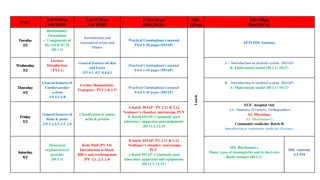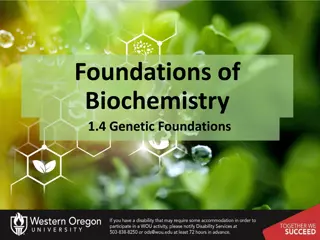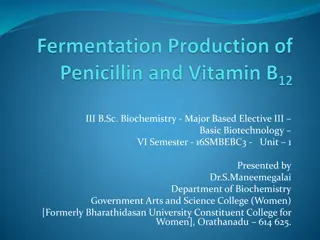Post-Production Processing of Yogurt: Types and Biochemistry
Dr. Sonia Kumari, Asst. Prof. & Jr. Scientist in Microbiology, outlines the various types of post-production processing for yogurt including pasteurized, liquid, carbonated, frozen, dietetic, and probiotic yogurts. She details the nutritional facts and types of probiotic yogurts available, discussing the beneficial cultures used in each. The content delves into the biochemistry of yogurt and how freezing, diet modifications, and culturing techniques can alter the final product.
Download Presentation

Please find below an Image/Link to download the presentation.
The content on the website is provided AS IS for your information and personal use only. It may not be sold, licensed, or shared on other websites without obtaining consent from the author.If you encounter any issues during the download, it is possible that the publisher has removed the file from their server.
You are allowed to download the files provided on this website for personal or commercial use, subject to the condition that they are used lawfully. All files are the property of their respective owners.
The content on the website is provided AS IS for your information and personal use only. It may not be sold, licensed, or shared on other websites without obtaining consent from the author.
E N D
Presentation Transcript
Dr.Sonia Kumari Asstt.Prof Cum Jr. Scientist Deptt. of Microbiology SGIDT,BASU,Patna
Post production processing of yoghurt into various types, Biochemistry of yoghurt Pasteurized Yoghurt: If yoghurt is heated after incubation, it is called as Pasteurizedyoghurt or Heated yoghurt"or Thermized yoghurt or UHT Yoghurt. Pasteurization of yoghurt can be done to improve the shelf-life. liquid/drinking yoghurt: Yoghurt is cooled to about 20-25 and then stirred with addition of pasteurized water. The quantity of water depends upon the final total solids desired in the product. Liquid yoghurt generally is defined as the one having less than 9% total solids. This product resembles to cultured buttermilk. It can spiced and taken as a refreshing beverage. Carbonated yoghurt: Carbondioxide is injected in stirred and diluted yoghurt to make carbonated yoghurt. The carbonation of finished yoghurt beverage improves its thirst quenching quality and enhance its refreshing character. It may have higher shelf-life but show more whey separation.
Post production processing of yoghurt into various types, Biochemistry of yoghurt Freezing (frozen yoghurt): The yoghurt base produced in conventional way and the mix can be prepared by adding several other ingredients including milk, cream, skim milk powder, etc. The mix is then frozen like ice-cream and air is incorporated to have over run. Yoghurt can be hard frozen, or can be served as soft with or without additional flavorings. Dietetic yoghurt: Various types of dietetic yoghurts can be prepared by supplementations of required ingredients and standardization. These may low fat yoghurt, low calorie yoghurt, high calcium yoghurt, etc. Most important form of dietetic yoghurts is the probiotic yoghurt, which is prepared by incorporation of probiotic culture in yoghurt. Lactose hydrolyzed yoghurt : This product is designed for lactose intolerant people. The milk is first treated with lactase to partially hydrolyse lactose and then finally heat treated and inoculated with yoghurt cultures. The product will have faster growth of starters requiring less incubation time. Yoghurt will be milder and sweeter
Types of Probiotic Yoghurts Name Culture Used Acido-Yoghurt (LB)+ S.thermophilus L.bulgaricus (ST)+0.25% of intestinal strain of L.Acidophilus (LB+ST) + L. acidophilus (Final product Acidophillus Yoghurt contain 30 millions /ml of L.acidophilus LB+ST+ L. acidophilus Acidophilus bifidus yoghurt Bioyoghurt ST+ L.acidophilus Bifighurt ST+B.bifidus Biograde ST+ L.acidophilus+B.bifidus
Nutritional facts of Yoghurt/100 gm Constituents Milk Yoghurt Whole Skim Full fat Low Fat Low fat/fruit Water 87.8 91.1 81.9 84.9 77.0 Energy value(kcal) Protein(g) 66 33 79 56 90 3.2 3.3 5.7 5.1 4.1 Fat(g) 3.9 0.1 3.0 0.8 0.7 Carbohydrates (g) Calcium(mg) 4.8 5.0 7.8 7.5 17.9 115 120 200 190 150 Phosphorus(mg ) Sodium(mg) 92 95 170 160 120 55 55 80 83 64 Pottassium(mg) 140 150 280 250 210 Zinc(mg) 0.4 0.4 0.7 0.6 0.5
Defects in yoghurt and remedies Sr. No. 1. Defect Whey Separation Settled Causes Over acidification, mechanical Remedies Homogenization, increase (Separation of Clear liquid at damage to curd, high total solids (Protein contentt > the top of the product) incubation temperature, law 3.5%), adequate heat total solids aeration, improper treatment of milk, low heat treatment of milk etc. incubation temperature o use of slime production, use of stabilizers et c. 2. Sour / High Acid Over incubation, slow cooling, Start early8 cooling, maintain contamination with wild LAB, low temperature, use least improper storage high rate of over acidifying cultures. enoclum 3. Insipid / Dull Under incubation, slow Incubate till PH <4.6, ensure culture, too early cooling after stapler activity & purity, incubation, page attack optimum temp. of incubation, higher rate of inoculation
Defects in yoghurt and remedies 4. Bitter taste / sweet Combination by Hygenic Care, curding aerobic spore formers Sufficient heat prodeo lytic action treatment of milk 5. Gassiness bulying Growth of Prevent contamination, contaminates like observe hygienic yeasts, coliforms conditions, maintain unhygienic conditions, cold chain un-refrigerated storage Contamination 6. Yeasty Flavor with Use strict hygienic yeast and molds practices to avoid contamination.
Defects in yoghurt and remedies 7. Ropiness/ sliminess Slime producing micro Use appropriate contaminants, too low incubation temp. temperature of incubation Prevent too high concentration of contamination with stabilizers slime produces low level of stabilizers. Prevent contamination 8. Rancid / oxidized stale Improper storage, contamination with fat with biolytic organism degraders exposure to light prevent light exposure, low temperature storage
Applications of yoghurt for therapeutic benefits are listed below. Applications of yoghurt for therapeutic benefits are listed below. Used as therapeutic agents in gastro-intestinal disorders: Yoghurt flora is known to inhibit several food spoilage organisms and intestinal pathogens due to presence of several inhibitory substance and low pH. This helps in prevention of infections and control of several gastro-intestinal tract illness including diarrhea and constipation. Can be digested by lactose intolerant people: Yoghurt has lower lactose due to fermentation and it also provides lactase from autolysed bacteria in gut and hence it helps in digestion of lactose. May have hypocholesterolemic activity: There are some reports that yoghurt flora can reduce cholesterol in the body by different mechanisms. This can help in reducing the risk of heart diseases.
Applications of yoghurt for therapeutic benefits are listed below. Anticarcinogenic activities: Yoghurt, especially having probiotic cultures are known to have some tumor inhibiting properties. They also reduce the activity of enzymes that convert procarcinogen to carcinogen in gut which reduces the possibility of colon cancer. Immunostimulatory properties: Increase in specific and non-specific immune function shave been reported by consumption of fermented milks. Some reports on anti-mutagenic activity are also published. Other applications: Yoghurt and other fermented milk products have been found to be useful in several other health conditions also. However, the therapeutic effect is dependant on the strain of the culture used for the preparation of the product. .









